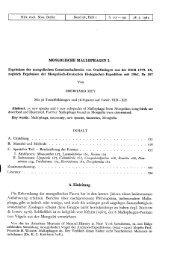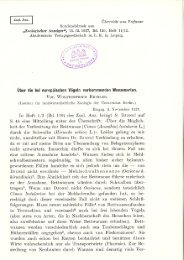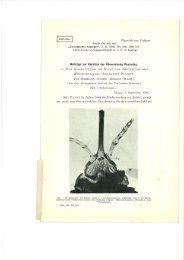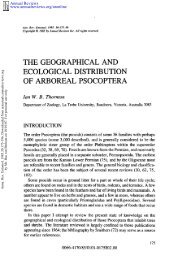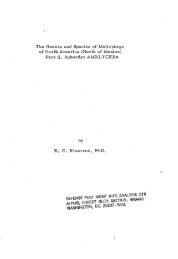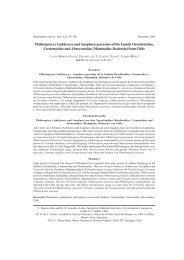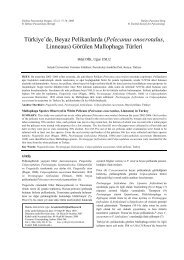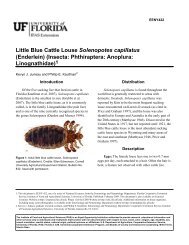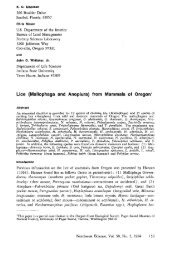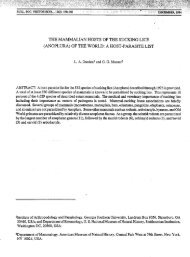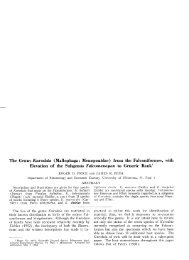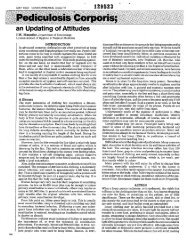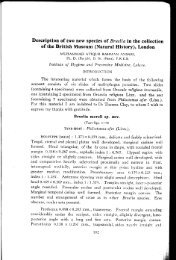The population dynamics and host utilization of ... - Phthiraptera
The population dynamics and host utilization of ... - Phthiraptera
The population dynamics and host utilization of ... - Phthiraptera
You also want an ePaper? Increase the reach of your titles
YUMPU automatically turns print PDFs into web optimized ePapers that Google loves.
298 1%. W. Rust<br />
litters <strong>and</strong> between litter mates. This explains the adult sex differences<br />
<strong>and</strong> small louse <strong>population</strong> (inoculum) on juvenile gophers. Miller (1946)<br />
found an average <strong>of</strong> 5 young/litter <strong>and</strong> 2 litters/year for gophers inhabiting<br />
irrigated fields in the Davis area. Thus, ideally 84% <strong>of</strong> the female's<br />
louse <strong>population</strong> could be lost twice a year. Actual measurements <strong>of</strong> the<br />
proportion <strong>of</strong> the <strong>population</strong> lost ranged from 56% to 66% for litter<br />
sizes <strong>of</strong> 2 <strong>and</strong> 4 (N=4).<br />
Lice are generally found on the head <strong>and</strong> foreparts <strong>of</strong> the small<br />
mammals <strong>and</strong> may spread over the dorsal <strong>and</strong> lateral aspects <strong>of</strong> the <strong>host</strong><br />
as the <strong>population</strong> increases (Vysotoskaya, 1950; Dubinin, 1953; Murray,<br />
1961). In general, louse distribution is controlled by the grooming<br />
characteristics <strong>of</strong> the <strong>host</strong> (Murray, 1961). Observations <strong>of</strong> gopher<br />
grooming indicate that lice can be nipped from the ventral body <strong>and</strong><br />
possibly the hind quarters. <strong>The</strong> short neck <strong>and</strong> large pectoral girdle<br />
prevent more extensive preening with incisors. Preening with the hind<br />
<strong>and</strong> fore claws in the form <strong>of</strong> scratching probably does not remove many<br />
lice because <strong>of</strong> their tenacity. This action could destroy stationary nits,<br />
but gophers were observed to rub the head region with their fore claws<br />
rather than scratch with claw tips.<br />
Preening is an important control agent in the distribution <strong>of</strong> nits<br />
(Murray, 1961), but hair size <strong>and</strong> configuration (Murray, 1957b-d;<br />
Hopkins <strong>and</strong> Chamberlain, 1969) <strong>and</strong> <strong>host</strong> regional body temperatures<br />
(Murray, 1957e, 1963b, 1965) also affect their distribution. Another<br />
factor on the gopher is the structure <strong>of</strong> the hairs on which eggs are glued.<br />
Most hair follicles on the gopher contain 9-18 hairs (Morejohn <strong>and</strong><br />
Howard, 1956), but the character <strong>of</strong> hairs per follicle differs in the<br />
various body regions. Hair follicles on the dorsal <strong>and</strong> lateral aspects <strong>of</strong><br />
the head bear 4-6 large guard hairs <strong>and</strong> 7-12 fur hairs, whereas follicles<br />
on the dorsal body lack the stiff guard hairs. Follicular separation is<br />
nearly equal over the body, with the hairs follicles being separated by<br />
0.25-0.33 ram. <strong>The</strong> response <strong>of</strong> female lice to a particular hair configuration<br />
for oviposition may result in the limited distribution as seen<br />
on over 80% <strong>of</strong> the gophers sampled. On juveniles, all hairs are <strong>of</strong> the<br />
fur type <strong>and</strong> thus the possible wider distribution <strong>of</strong> nits, but as the<br />
gopher loses its juvenile pelage the hair per follicle change to the fur<br />
hair-guard hair arrangement. <strong>The</strong> wider distribution <strong>of</strong> nits on gophers<br />
with large infestations (800-~) possibly indicates a spreading to less<br />
favorable sites.<br />
Molting restricts the availability <strong>of</strong> oviposition sites <strong>and</strong> may result<br />
in a loss <strong>of</strong> eggs already laid. Evidence for the latter is sparse, although<br />
Vysotoskaya (1950) considered molting a major factor for <strong>population</strong><br />
decline. Three gophers with active molt lines in <strong>and</strong> around the ears <strong>and</strong><br />
eyes had no unhatched nits in the area. When examined 30 days later the



